Serving 1,606 students in grades 7-12, Palatka Jr - Sr High School ranks in the bottom 50% of all schools in Florida for overall test scores (math proficiency is bottom 50%, and reading proficiency is bottom 50%).
The percentage of students achieving proficiency in math is 31% (which is lower than the Florida state average of 52%). The percentage of students achieving proficiency in reading/language arts is 29% (which is lower than the Florida state average of 52%).
The student:teacher ratio of 22:1 is higher than the Florida state level of 17:1.
Minority enrollment is 50% of the student body (majority Black), which is lower than the Florida state average of 65% (majority Hispanic and Black).
Quick Stats (2025)
- Grades: 7-12
- Enrollment: 1,606 students
- Student:Teacher Ratio: 22:1
- Minority Enrollment: 50%
- Graduation Rate: 89% (Top 50% in FL)
- Overall Testing Rank: Bottom 50%
- Math Proficiency: 31% (Btm 50%)
- Reading Proficiency: 29% (Btm 50%)
- Science Proficiency: 26% (Btm 50%)
- Source: National Center for Education Statistics (NCES), FL Dept. of Education
School Overview
Palatka Jr - Sr High School's student population of 1,606 students has grown by 45% over five school years.
The teacher population of 74 teachers has grown by 48% over five school years.
Grades Offered
Grades 7-12
Total Students
1,606 students
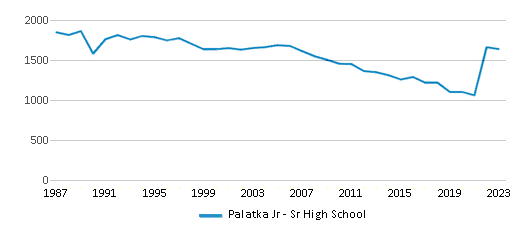
Gender %
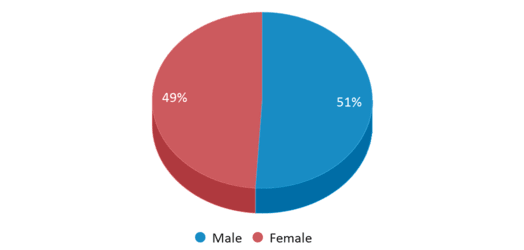
Total Classroom Teachers
74 teachers
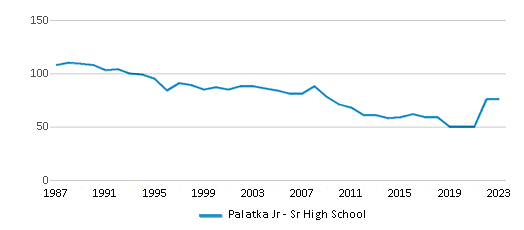
Students by Grade
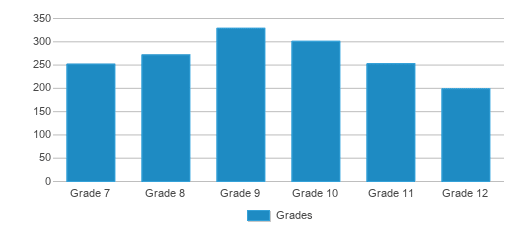
School Rankings
Palatka Jr - Sr High School ranks within the bottom 50% of all 3,704 schools in Florida (based off of combined math and reading proficiency testing data).
The diversity score of Palatka Jr - Sr High School is 0.60, which is less than the diversity score at state average of 0.70. The school's diversity has stayed relatively flat over five school years.
Overall Testing Rank
#3283 out of 3704 schools
(Bottom 50%)
(Bottom 50%)
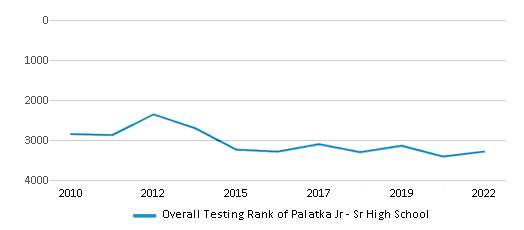
Math Test Scores (% Proficient)
31%
52%
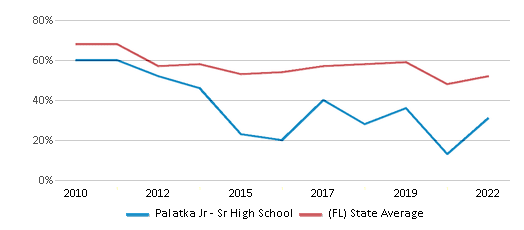
Reading/Language Arts Test Scores (% Proficient)
29%
52%
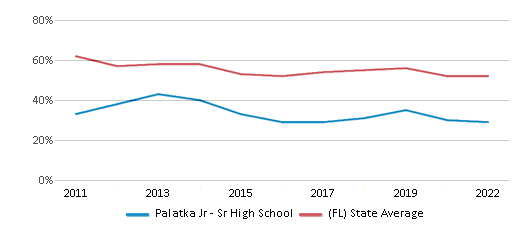
Science Test Scores (% Proficient)
26%
52%

Student : Teacher Ratio
22:1
17:1
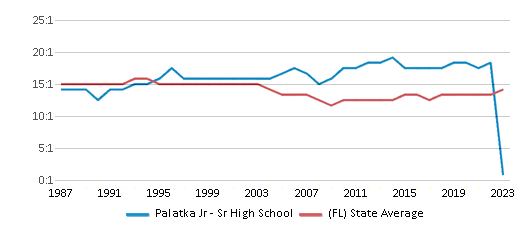
American Indian
n/a
n/a
Asian
n/a
3%
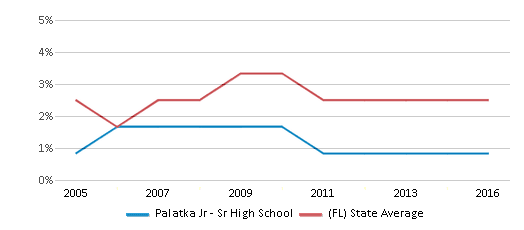
Hispanic
9%
37%

Black
38%
21%
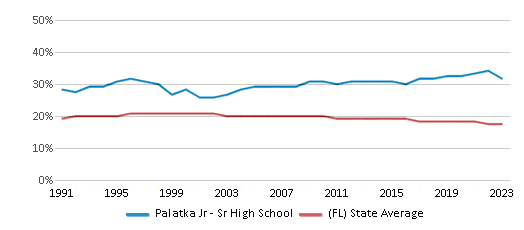
White
50%
35%
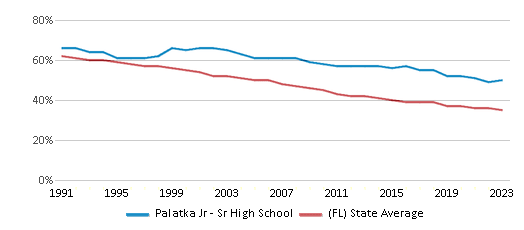
Hawaiian
n/a
n/a
Two or more races
3%
4%
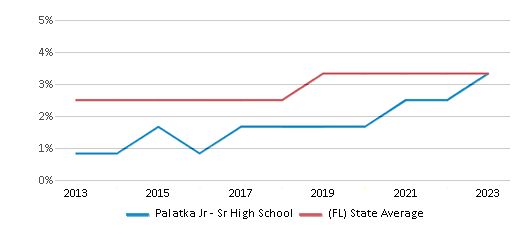
All Ethnic Groups
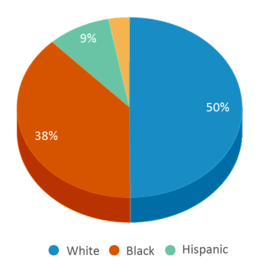
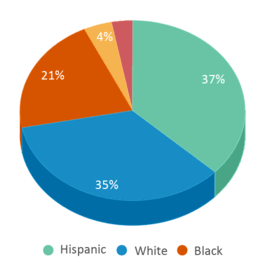
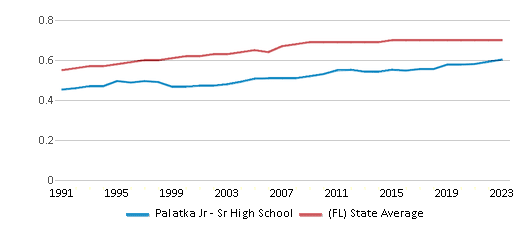
Graduation Rate
89%
87%
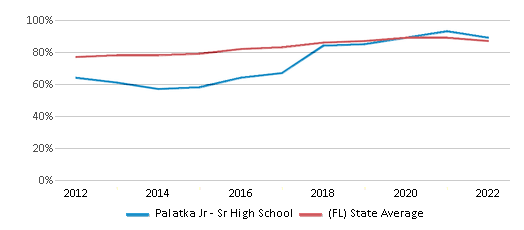
Participates in the National School Lunch Program (NSLP)
Yes
Eligible for Free Lunch
62%
47%
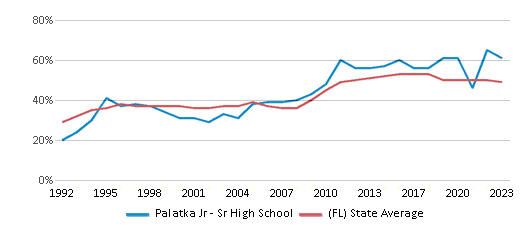
Eligible for Reduced Lunch
4%
4%
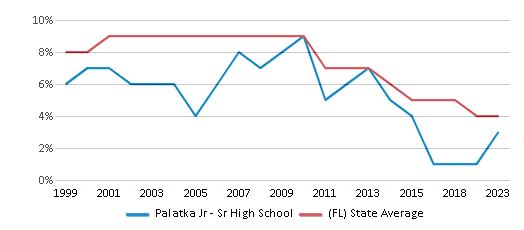
School Statewide Testing
School District Name
Source: National Center for Education Statistics (NCES), FL Dept. of Education
Profile last updated: 02/09/2025
Frequently Asked Questions
What is Palatka Jr - Sr High School's ranking?
Palatka Jr - Sr High School is ranked #3283 out of 3,704 schools, which ranks it among the bottom 50% of public schools in Florida.
What schools are Palatka Jr - Sr High School often compared to?
Palatka Jr - Sr High Schoolis often viewed alongside schools like Interlachen Jr-sr High School, Crescent City Jr-sr High School, Putnam Edge High School by visitors of our site.
What percent of students have achieved state testing proficiency in math and reading?
31% of students have achieved math proficiency (compared to the 52% FL state average), while 29% of students have achieved reading proficiency (compared to the 52% FL state average).
What is the graduation rate of Palatka Jr - Sr High School?
The graduation rate of Palatka Jr - Sr High School is 89%, which is higher than the Florida state average of 87%.
How many students attend Palatka Jr - Sr High School?
1,606 students attend Palatka Jr - Sr High School.
What is the racial composition of the student body?
50% of Palatka Jr - Sr High School students are White, 38% of students are Black, 9% of students are Hispanic, and 3% of students are Two or more races.
What is the student:teacher ratio of Palatka Jr - Sr High School?
Palatka Jr - Sr High School has a student ration of 22:1, which is higher than the Florida state average of 17:1.
What grades does Palatka Jr - Sr High School offer ?
Palatka Jr - Sr High School offers enrollment in grades 7-12
What school district is Palatka Jr - Sr High School part of?
Palatka Jr - Sr High School is part of Putnam School District.
School Reviews
1 3/25/2020
This is horribly run as challenges must be met. Special Education is necessary as average and top flight students are hampered by bad behaviour, special needs that has to be addressed. Parent backing disrupts the success chain. There is no music or art which is a travesty. These subjects are proven to help the main courses available. The head of schools here needed to help the quality of education and not rely just on graduation rates. This is a horrific situation as Palatka and Putnam Country are in the bottom 50%. This has to mean something to parents, Administration, and School Administration.
5 1/14/2014
my name is vanessa morgan i moved this year i recomment the school as well as the teacher MRS. ROllinson. The greatest woman i ever meet, she reallly cares about her kids(students) as well as there education
SIncerly,
Vanessa A. Morgan
Review Palatka Jr - Sr High School. Reviews should be a few sentences in length. Please include any comments on:
- Quality of academic programs, teachers, and facilities
- Availability of music, art, sports and other extracurricular activities
Recent Articles

What Is A Charter School?
Explore the world of charter schools in this comprehensive guide. Learn about their history, how they operate, and the pros and cons of this educational innovation. Discover key facts about charter schools, including admission policies, demographics, and funding, as well as what to look for when considering a charter school for your child.

10 Reasons Why High School Sports Benefit Students
Discover the 10 compelling reasons why high school sports are beneficial for students. This comprehensive article explores how athletics enhance academic performance, foster personal growth, and develop crucial life skills. From improved fitness and time management to leadership development and community representation, learn why participating in high school sports can be a game-changer for students' overall success and well-being.

February 05, 2025
Understanding the U.S. Department of Education: Structure, Impact, and EvolutionWe explore how the Department of Education shapes American education, from its cabinet-level leadership to its impact on millions of students, written for general audiences seeking clarity on this vital institution.









